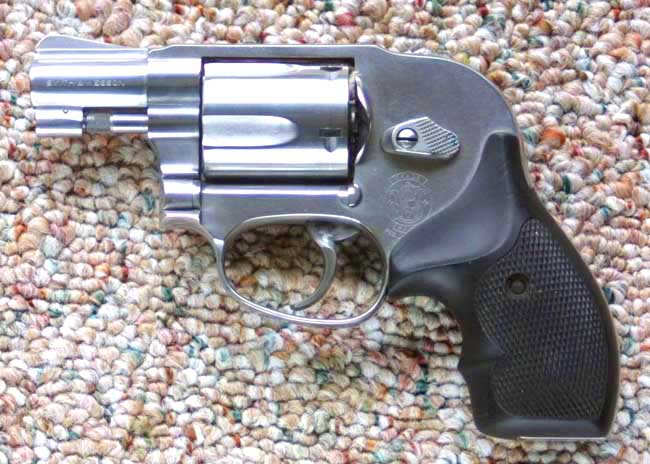 S&W M-649
S&W M-649
| Length Overall | Barrel Length | Weight | Caliber | Action Type | Magazine capacity |
| 6 1/4 Inches | 2" (1 7/8" some models) | 20 Ounces | .38 spcl | D.A.Revolver | 5 |
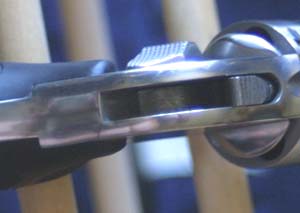 The strange hump backed shape is a result of a shrouded
hammer. A small, serrated, and somewhat flattened nub, barely protrudes through
a slot along the curve of the shroud. This permits the gun to be cocked and
fired in the single action mode. Either during a draw, or while firing inside
of a pocket, the shroud keeps the hammer from hanging up or snagging on the
clothing. This is one of the best designs for deep concealment, and the only
modern design, which allows firing from within the pocket. The slide of an
automatic, or the hammer of a revolver would quickly foul, and tangle during
this kind of shooting. Detail photographs of the hammer spur and shroud are
included here. The first shows the weapon with the hammer at rest, the second
shows it cocked. The hammer barely protrudes above the shroud, so that it
can scarcely be noticed when the piece is viewed from the side. The basic
gun, is the well regarded J frame, as is used in the Chief’s, and some other
small, hideout guns. This is Smith’s .32 frame, proportioned to the .32 Special
round. The frame can be used for guns chambered in .38, by reducing the capacity
from 6 to 5. Like all of the short barreled J frame revolvers, the ejector
rod in this model is too short to clear the empties completely from the cylinder.
The cylinder can also hang, during swing out, if one of the cylinder flutes
is not aligned with the edge of the frame. These are minor complains, and
are somewhat to be expected in a gun designed to be so compact.
The strange hump backed shape is a result of a shrouded
hammer. A small, serrated, and somewhat flattened nub, barely protrudes through
a slot along the curve of the shroud. This permits the gun to be cocked and
fired in the single action mode. Either during a draw, or while firing inside
of a pocket, the shroud keeps the hammer from hanging up or snagging on the
clothing. This is one of the best designs for deep concealment, and the only
modern design, which allows firing from within the pocket. The slide of an
automatic, or the hammer of a revolver would quickly foul, and tangle during
this kind of shooting. Detail photographs of the hammer spur and shroud are
included here. The first shows the weapon with the hammer at rest, the second
shows it cocked. The hammer barely protrudes above the shroud, so that it
can scarcely be noticed when the piece is viewed from the side. The basic
gun, is the well regarded J frame, as is used in the Chief’s, and some other
small, hideout guns. This is Smith’s .32 frame, proportioned to the .32 Special
round. The frame can be used for guns chambered in .38, by reducing the capacity
from 6 to 5. Like all of the short barreled J frame revolvers, the ejector
rod in this model is too short to clear the empties completely from the cylinder.
The cylinder can also hang, during swing out, if one of the cylinder flutes
is not aligned with the edge of the frame. These are minor complains, and
are somewhat to be expected in a gun designed to be so compact. Like most small guns, the M649 can be carried in a selection of hide out holsters. There are the usual ankle, belly band,
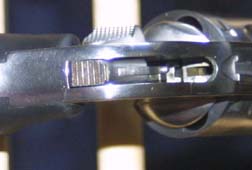 inside the waist, and hip holsters, but there is also something unique to
this design. A pocket holster is produced for this gun. This is a square
piece of leather, with a skeletonized holster installed. The holster is bent
to fit in the pocket, and then flattened out, once inserted. The gun is then
slipped into the holster. Most people might ask why it would be necessary
to have a holster inside of a pocket, but there are a couple of advantages.
The most obvious advantage, is that the lines of the gun are broken, so that
it does not “print” through the pocket to reveal that the owner is armed.
The pocket holster also insures that the pistol is always properly positioned
in the same place for a sure presentation (presentation is the politically
correct term for what used to be called the draw). Without the pocket holster,
these little guns tend to ride around in the pocket, and shift, to lie on
their backs.
inside the waist, and hip holsters, but there is also something unique to
this design. A pocket holster is produced for this gun. This is a square
piece of leather, with a skeletonized holster installed. The holster is bent
to fit in the pocket, and then flattened out, once inserted. The gun is then
slipped into the holster. Most people might ask why it would be necessary
to have a holster inside of a pocket, but there are a couple of advantages.
The most obvious advantage, is that the lines of the gun are broken, so that
it does not “print” through the pocket to reveal that the owner is armed.
The pocket holster also insures that the pistol is always properly positioned
in the same place for a sure presentation (presentation is the politically
correct term for what used to be called the draw). Without the pocket holster,
these little guns tend to ride around in the pocket, and shift, to lie on
their backs. A pocket holster, along with a couple of speed strips, or speed loaders, can render a user in any kind of clothing, reasonably well armed, though with little indication of it. There are some other models, designed along the same lines as the M49/649, but none seem to do the job quite as well. A number of companies have bobbed the hammers on their small frame, short barreled revolvers. Taurus, and even S&W themselves have produced such models. There are even semi automatics with bobbed hammers, though this is generally used as a safety feature rather than a
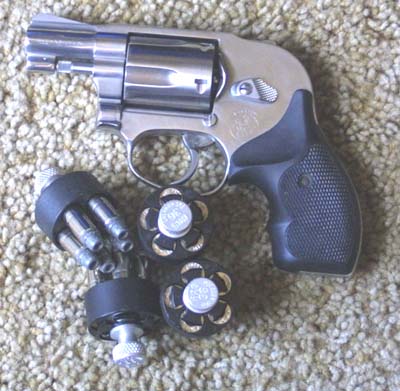 concealment feature. There are also models, such as the S&W 422, which
have their bobbed hammers completely enclosed. Enclosed hammer/bobbed hammer
guns, can not be cocked for single action fire; many are double action only
designs. Though any competent hand gunner should be able to fire a revolver
reasonably well in double action mode, there will always be occasions when
the slight edge of a crisp single action trigger might make all of the difference.
Both the single and double action trigger pulls on this particular example
are superb.
concealment feature. There are also models, such as the S&W 422, which
have their bobbed hammers completely enclosed. Enclosed hammer/bobbed hammer
guns, can not be cocked for single action fire; many are double action only
designs. Though any competent hand gunner should be able to fire a revolver
reasonably well in double action mode, there will always be occasions when
the slight edge of a crisp single action trigger might make all of the difference.
Both the single and double action trigger pulls on this particular example
are superb. Stainless construction is particularly well suited for a gun designed to fill this role. Deep concealment pistols are typically subject to heat, moisture, salt, and other harmful agents in some of the odd and out of the way places in which they are carried. This is a high quality rig, and is vastly preferable to the little .22 or .25 caliber autos generally employed in this role. Though there are now small frame 357 revolvers being made (including a version of the M49 in 357) there is little ballistic advantage out of the short barrel, and a large increase in recoil, flash, and noise. This is one of the few firearms in the current S&W line which has, through the years, retained it's model name. Smith calls this series of guns the Bodyguard, which should give a pretty good clue as to it's intended role. The gun is nearly ideal for the detective (or bodyguard), Rosie O'Donell employee, armed citizen, or any other person who may wish to be casually, and unobtrusively armed, while retaining quick access without the use of a hip or shoulder holster system (though both are available for this model).
This particular example sports a nice set of rubber combat grips, with finger cut outs. The grips are cut down, to match the size of the frame, and offer only a two finger hold. The standard wooden grips for this model, and similar guns like the Chief's, are much thinner, but somewhat longer, giving a full handed grip, but less to hang on to. I prefer the rubber grips, but preferences vary. I wish I could say that I can shoot winning scores with this gun, but down at the range, I am lucky to shoot a 4" group. Still, this is not exactly a target gun, and another shooter, more used to the J frame Smiths might do a bit better. I will
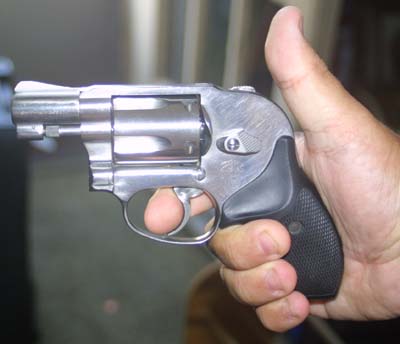 have to practice. This is my first, and for the moment, my only J frame Smith.
With standard 38 Special loads, the M649, though not exactly pleasant, is
not overly objectionable to shoot. Even so, I can not imagine why anyone would
want to own the 357 version of this gun. Out of the short barrel, a 158 grain
38 will achieve about 850 fps. Out of the same barrel, a 357 magnum will
do about the same, if it is loaded with a fast powder. Most magnum loads
use slower burning powders than standard calibers, and it is possible for
a 357 to generate less velocity out of a 2" barrel than a standard 38. For
most purposes, the two rounds are the same, out of a barrel this small, so
I opt to use the easier shooting 38. The 850 fps is not really enough velocity
to open up hollow points, but I use them anyway. I have worked on some loads,
using Bullseye, and similar fast powders, which can generate some pretty good
velocity out of these small barreled guns. The proof will have to wait until I
acquire a chronograph (soon, I hope), and find the time to assemble some
performance tables with various loads, powders, and barrel lengths. In the
meantime, I just have to wait.
have to practice. This is my first, and for the moment, my only J frame Smith.
With standard 38 Special loads, the M649, though not exactly pleasant, is
not overly objectionable to shoot. Even so, I can not imagine why anyone would
want to own the 357 version of this gun. Out of the short barrel, a 158 grain
38 will achieve about 850 fps. Out of the same barrel, a 357 magnum will
do about the same, if it is loaded with a fast powder. Most magnum loads
use slower burning powders than standard calibers, and it is possible for
a 357 to generate less velocity out of a 2" barrel than a standard 38. For
most purposes, the two rounds are the same, out of a barrel this small, so
I opt to use the easier shooting 38. The 850 fps is not really enough velocity
to open up hollow points, but I use them anyway. I have worked on some loads,
using Bullseye, and similar fast powders, which can generate some pretty good
velocity out of these small barreled guns. The proof will have to wait until I
acquire a chronograph (soon, I hope), and find the time to assemble some
performance tables with various loads, powders, and barrel lengths. In the
meantime, I just have to wait.